Methaphysics & Spirituality — Issue 9, 2018
THE ZOROASTRIAN FLAME
Khojeste Mistree talks about one of the world’s oldest surviving religions and what we can learn from it in the present day
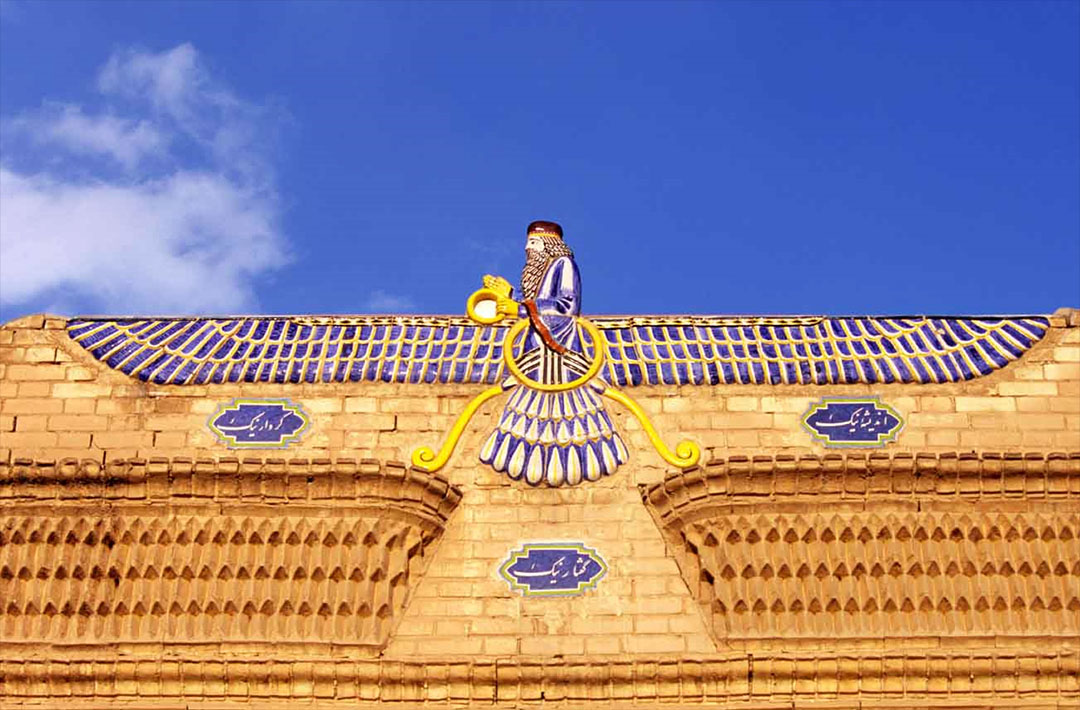

THE ZOROASTRIAN FLAME
Khojeste Mistree talks about one of the world’s oldest surviving religions and what we can learn from it in the present day
Zoroastrianism has an unbroken tradition going back 3,500 years. It is now the faith of a relatively small community centred in Western India and Iran, which continues to tend the sacred flame of its unique vision. Recent years have seen growing Western interest in the tradition, with a major London exhibition at The School of African and Oriental Studies (SOAS) in 2013, and the establishment of a chair of Zoroastrian Studies. Khojeste Mistree is an elder of the Zoroastrian community in Mumbai, the co-founder of the Zoroastrian Studies Foundation, and author of a comprehensive introduction ‘Zoroastrianism: an Ethnic Perspective’. Here he talks to David Hornsby about the very practical teachings of this ancient spiritual path and how its vision is still relevant in the modern world.
David: We know that Zoroastrianism is a very ancient spiritual tradition. But what do we know about its origins?
Khojeste: We believe that the Prophet Zarathushtra was born in about 1500 bce, in the region of the Aral Sea, in an area which is now between Kazakhstan and Uzbekistan. But there is no written material from the early centuries, so the recorded history of Zoroastrianism really starts from the advent of Cyrus the Great, who was the founder of the Achaemenian Empire in 550 bce. Zarathustra left behind a message in the form of a series of prayers called The Gāthās [/], 17 chapters, which were passed down faithfully through an oral tradition. But even these were not systematically written down until about the sixth century ce.
David: At the time of the Achaemenian Empire – which was huge, stretching from Eastern Europe to Sind in India – Zoroastrianism was the state religion, and it continued to be so under the Parthians and Sassanians. So for many centuries it was the dominant faith in the Middle East. But these days, I believe the number of followers is relatively small, about 125,000 people.
Khojeste: That’s the figure that has been suggested, yes. We are not sure whether that’s an accurate figure, because it’s been virtually impossible to do a global census of all the places where Zoroastrians now live. If we take the 125,000 figure, we are talking about people who are born Zoroastrians, that is, those whose parentage happens to be Parsi/Irani by birth or ethnicity. These people mainly live in India, particularly in Mumbai, and in Iran, North America, UK, Europe and Australasia. But there are pockets of Zoroastrians today whom I would address as neo-Zoroastrians, who wish once again to come back to their heritage, largely because they are so disillusioned with the regimes in the Middle East. For example, there is a sizeable Kurdish community that now professes to be Zoroastrian. These are people living in northern Iraq, Syria, Iran – that sort of region; and there are also others who genuinely want to become Zoroastrians because they are attracted by the ideology of the faith.
David: It seems that there is a lot of interest in Zoroastrianism at the moment, and a growing understanding of the extent to which it has influenced other religious traditions.
Khojeste: We believe that Zoroastrianism greatly influenced Judaism and Christianity, and then trickled through to Islam. This ‘osmosis’ particularly seems to have happened with the afterlife doctrine. The concepts of heaven and hell, individual judgement, resurrection of the body, the last judgement, the coming of the Messiah – these are mainstream Zoroastrian theological ideas which entered post-exilic Judaism around the fourth century bce. From my understanding of Judaism, it did not originally have a defined ideology as far as its eschatology was concerned.
One must also also bear in mind that a Zoroastrian ruler, Phrates IV, was ruling Jerusalem in 40 bce. So when Jesus was born, there was a very strong Zoroastrian influence in that part of the world. In the New Testament we have the story of the Magi, who came to greet the baby Jesus in his crib. These ‘wise men’ were Zoroastrian travellers from the east, following the star of Bethlehem. They thought that the messiah was going to be a Zoroastrian messiah, and therefore came with gifts for the baby. In that sense, they got their sums wrong.

The Three Wise Men in Iranian costume. Mosaic in the Basilica of Sant’Apollinare Nuovo, in Ravenna, Italy, completed within 526 ad by the so-called ‘Master of Sant’Apollinare’. Detail from Mary and Child, Surrounded by Angels
David: There is also much speculation about an even earlier influence on Greek philosophy, I understand.
Khojeste: Zoroastrianism was the state religion of Iran from 550bce to about 651ce, when the region was conquered by Arab forces. That is a period of 1100 years, with only an 80-year interlude when the region was ruled by the Greeks. Of course the Iranians and the Greeks fought all the time, but I think it’s important to note that Herodotus, Plato, Aristotle, Hermidorus – in fact many of the big names in Greek philosophy – all had Zoroastrian teachers, known as the Magis, who were part of the Zoroastrian ‘clergy’ of that period. Just as a matter of interest, this is also where the word ‘magic’ comes from.
So some of the theological concepts of Zoroastrianism entered Greek thinking at a formative stage. The concept of the Golden Mean [/], and the use of the mind, which the Greek philosophers developed – all this was present in Zoroastrianism. Therefore, Zoroastrianism not only influenced the occidental religions, but also influenced Greek philosophical thought, and then, if you extend that further, Western civilisation, which is based upon Greek thought. So in an indirect way Zoroastrianism has had a profound influence upon Western civilisation in general.
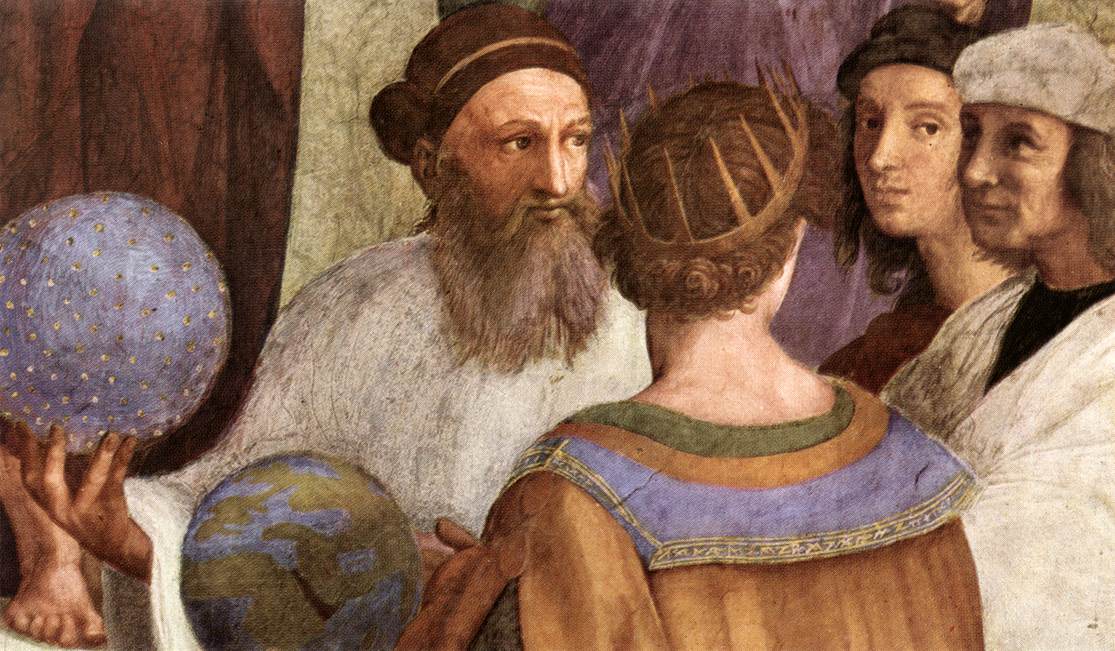
Detail from The School of Athens by Raphael, painted 1509, now held in the Vatican. Facing the viewer is a figure widely understood to be Zoroaster, holding the celestial sphere (although some commentators believe it to represent the astronomer Hipparchus). Opposite him is the astronomer Ptolemy, holding the sphere of the world. To his right, at the back, is a portrait of Raphael himself as the Greek painter Apelles
Contemporary Interest
David: You have lived in Mumbai now for nearly 40 years, but you were not born there, and in fact spent some years in England when you were younger.
Khojeste: I was born into a Zoroastrian community in Pune in India, and I came to England at a very early age – something like 16 or 17 – to attend a water divining conference. This was something I was very interested in, and I went on to do what you might call ‘acupuncture of the land’. After the conference, I stayed in the country and studied accountancy. I was articled to a firm and qualified as a chartered accountant, and was on the brink of being made a partner in my firm when I decided that I wanted to discover more about the Zoroastrian religion. So I ended up going to the University of Oxford to study Zoroastrianism at an academic level.
David: You studied in Oxford with Robert Zaehner, who was famous for his work on the mystical traditions of the world. But his early reputation was founded upon his pioneering work on Zoroastrianism and the books he wrote, such as The Wisdom of the Magi.
Khojeste: Professor Zaehner [/] was my tutor for just a year. But he died suddenly, and then I studied with Professor Mary Boyce [/], who was based in London. I used to visit her in London for my tutorials. Contact with her completely changed my life in terms of knowledge, and in terms of the sensitivity which she had towards the living faith. She had visited Iran in 1964, and also I think in 1966, and spent many months there. She lived with Zoroastrian villagers and meticulously recorded their oral tradition. I think that was a major breakthrough for Zoroastrianism in the West, because until then we had had great Western scholars, but their interest was more from a linguistic point of view, that is, the study of Avestan (the sacred language of Zoroastrianism) and middle Persian, translating the texts and things like that. It was not at all from the point of view of practice. Professor Boyce broke new ground by explaining the religion and the history, and linking both theology and practice to show a continuity of the faith. That is what excited me. She also showed me that there is a wonderful continuity from the time of the Prophet Zarathushtra right down to the present day Parsis/Iranis.
David: Then you returned to India, and started the Zoroastrian Studies Foundation in Mumbai?
Khojeste: Yes, I returned in 1980 because there seemed to be a lot of interest in Zoroastrianism being shown by the young and old Parsis living in Mumbai, and they invited me to give talks. For all these talks the auditoriums were jam-packed and I felt like a religious pop star! Obviously there was a thirst for knowledge within the community. Having studied in England and therefore being fluent in English, I was in a good position to talk to young people. In the 1970s and ’80s there was a great interest in matters esoteric, both here in the West as well as in India. That’s what launched Zoroastrian Studies, a Trust that I co-founded with a lady, Shehrnaz Panthaky, who is still with me in Mumbai. The idea was that we would offer structured courses on Zoroastrianism, and basically be like a filter house for those who wanted to know more about the faith.
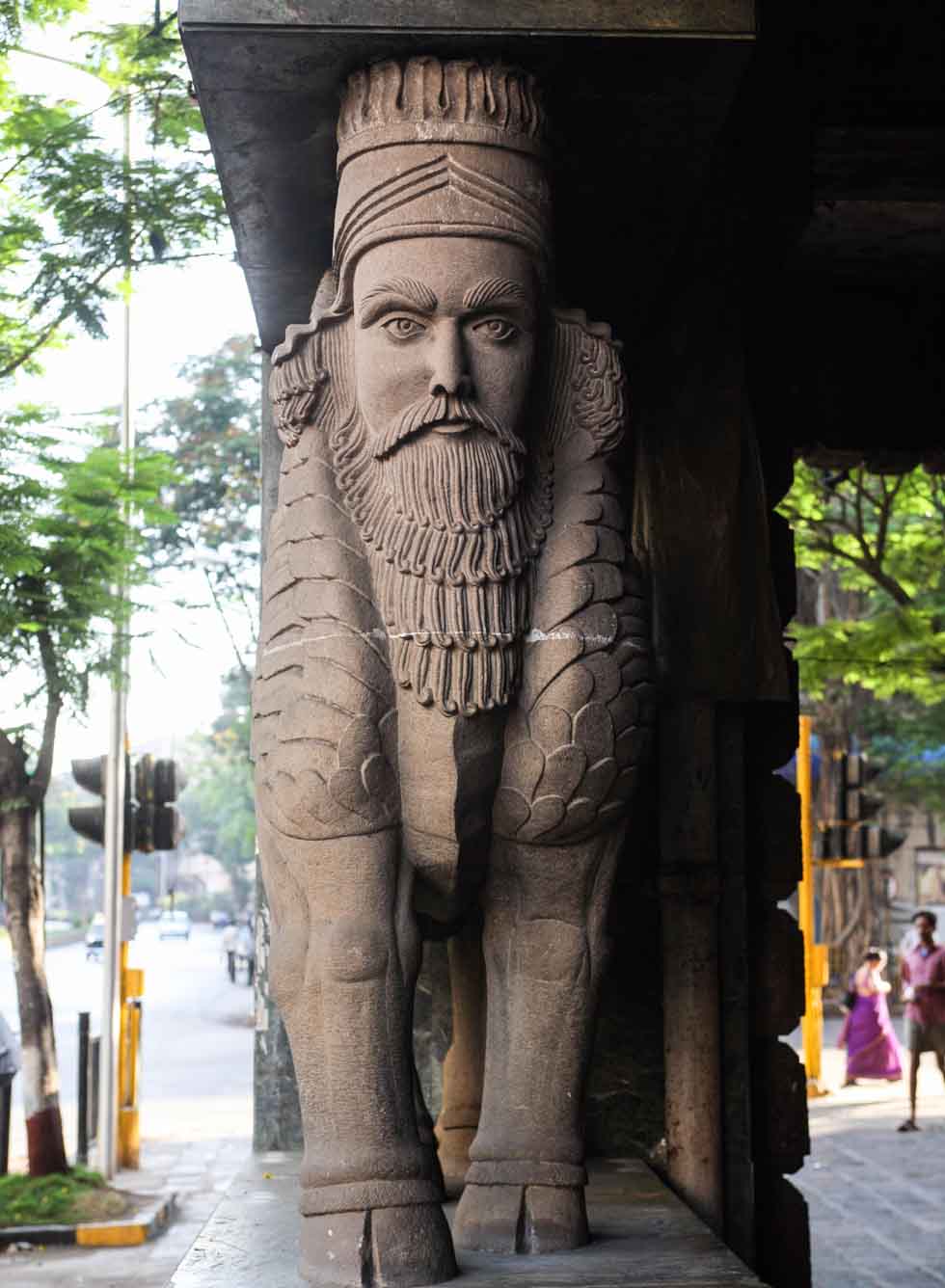
Winged oxen/bull sculpted in Persepolis/Iranian style at the entrance to a fire temple on D.N. Road, Mumbai. Photograph: Paul Quayle / Alamy Stock Photo
David: It’s interesting that having studied in England, you went to Mumbai, the global centre of the Zoroastrian community, to pass on knowledge that you had learnt there. Or was it rather that the people there had the knowledge, but they couldn’t find a way of communicating it in a modern context?
Khojeste: I would say that it was more the way of communicating, plus the fact that I had been trained in a very strict way at Oxford University. Since then things have developed a great deal in Zoroastrian studies. When Mary Boyce died she willed a large amount of money for a professorship to be established at SOAS. The chair was also funded by the Zartoshty brothers [/] – who had been my sponsors – so it is known today as the Zartoshty Brothers Chair of Zoroastrianism. That happened in 2011. Then recently, just last year in July 2017, the Mistry Foundation – not my family! – gave five million pounds to SOAS to encourage the study of Zoroastrianism from an anthropological perspective [/], meaning the study of the day-to-day tradition and the rituals and so forth. Academia is much more open these days to a holistic way of tackling religious knowledge – studying the oral tradition, talking to people, recording their experiences, etc. This is important because the older generation has a great deal of knowledge, but it is being lost; nobody to date has bothered to tape it, or write it down, and it wasn’t being communicated to the next generation.
SOAS is still the only place in the world doing this. It’s surprising that in a city like Mumbai, which was in many ways founded by Parsis, no benefaction has ever been given to set up a Zoroastrian professorship. Bombay University was greatly funded by Parsi philanthropy, and yet our forebears didn’t think of establishing a chair there.
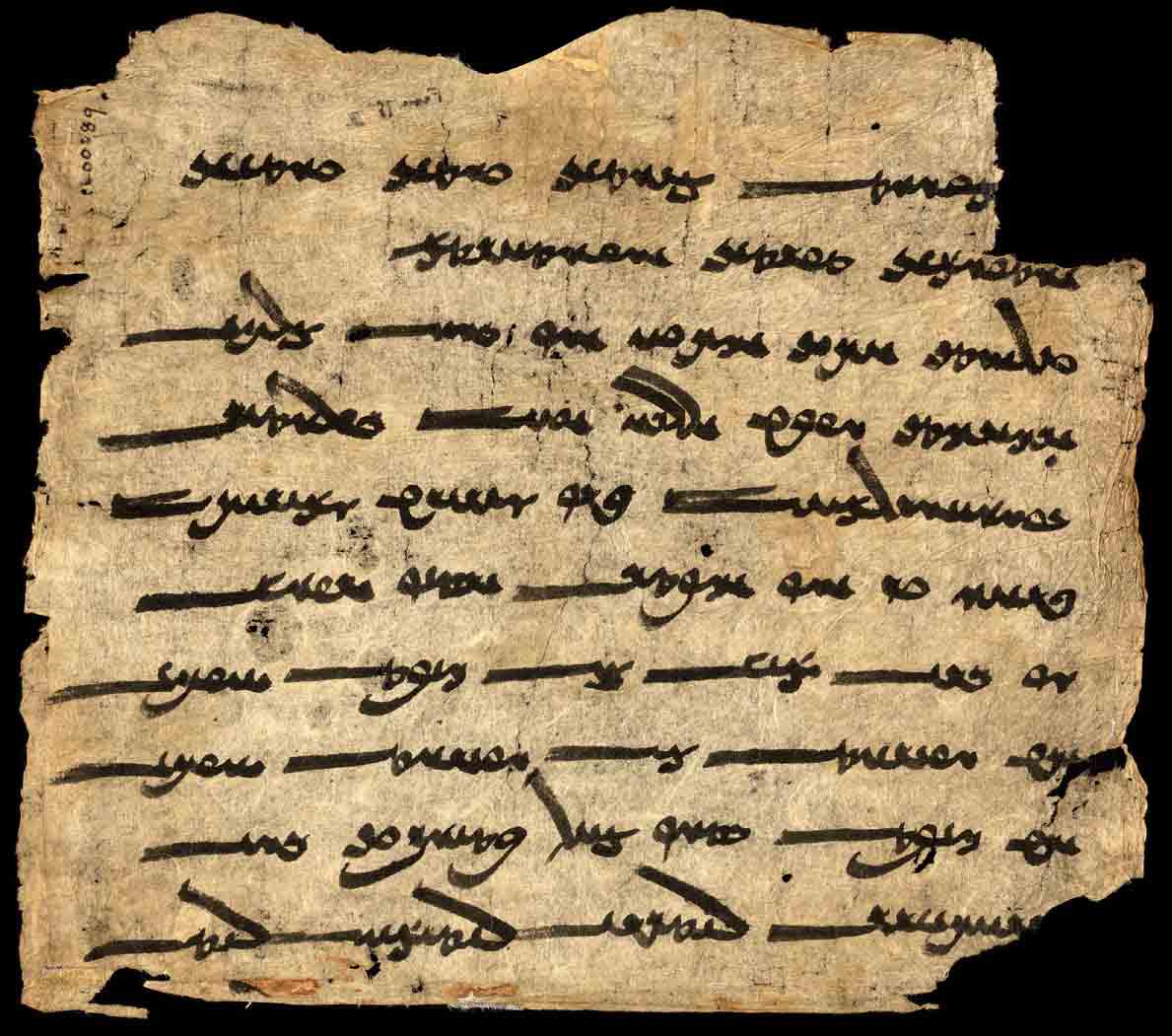
The oldest surviving Zoroastrian text, written in the 9th century in Sogdian, a medieval Iranian language. It contains a phonetic transcription of the holy Ashem Vohu prayer, which was written originally in Avestan. It was discovered in the ‘Cave of a Thousand Buddhas’ in Dunhuang, China. Read more… [/] Image: British Library Or 8212/84©British Library
David: In the 1960s and ’70s, a lot of western youth went to India looking for ancient knowledge, sitting at the feet of gurus and wise people. But Zoroastrianism has never had the high profile that some of these had.
Khojeste: You’re right. Zoroastrianism has not had a ‘high profile’ guru as you put it, ever. In a sense we are too small for that. Zoroastrianism is a religion that is practiced by those born into the religion, and while there is a sense of sharing at the spiritual level, it’s not okay to just accept people from the outside to come into the faith. We do not proselytise, and in that sense our religious paradigm is like the Jews and the Hindus. For example, I cannot become a Brahmin, Kshatriya, Vaishya, Shudra, because I am not born into the Hindu caste system. But there has always been a great niche interest in Zoroastrianism. I am actually amazed at the number of non-Zoroastrians interested to know more about it. I think it is because it has a very interesting ideology – one which is extremely relevant to modern man.
David: In fact, Zoroastrianism still has quite a presence in modern culture. There is Nietzsche, who entitled his most famous work Thus Spake Zarathushtra, and John Fowles’ The Magus. There is also the contemporary contribution of writers like Rohinton Mistry, who has made his name writing about the modern day community in Mumbai.
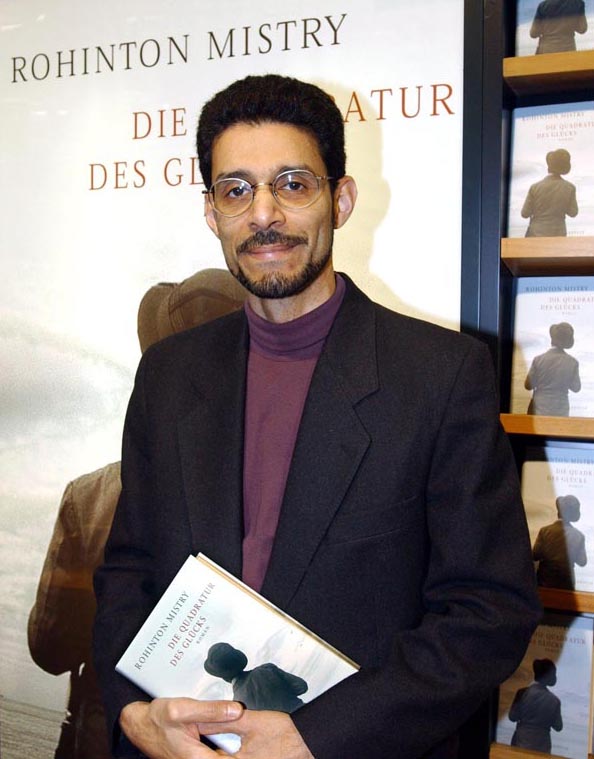
The celebrated Parsi writer Rohinton Mistry presents his novel, Family Matters at the Frankfurt Book Fair in 2002. Photograph: dpa picture alliance / Alamy Stock Photo
Living the Balanced Life
David: But to move on; this is an interview for Beshara Magazine, and Beshara is not ethnocentric – quite the opposite. You described Beshara once as the coming together of different spiritualities and different people in a continuing spirit; so what would you say are the universally applicable characteristics of Zoroastrianism that have meaning for all of us, whether or not we’re practitioners of the religion.
Khojeste: One of the most important principles of the Zoroastrian way of life is to promote harmony in this world, and we believe that harmony begins by being happy within ourselves. If we are happy and content within ourselves, then our primary task is to share that, so that there’s harmony in the environment. Harmony in the environment is what modern man calls ecology, looking after the planet, looking after the seven creations.
For example, a spiritual Zoroastrian is somebody who generates wealth honestly but shares it. Benefaction is a very important duty as far as we are concerned, and the Parsis are known for their benefaction. Considering that we are so few in numbers, the charities that we have promoted are extensive, for the community as well as beyond it. Also, Zoroastrians do not encourage celibacy or fasting. We do not encourage flagellation of the body. We do not encourage abstinence. We do not encourage sleeping on a bed of nails, or punishing the body in any way. From a Zoroastrian point of view happiness is a central feature, and because of this we are enjoined to look after our body.
Hence, you tend to find plump Zoroastrians, enjoying the good life. The point that I’m making to you is that we recognise our body to be the temple of the divine, of Ahura Mazda, because it is in the mind that we have wisdom and knowledge. The Golden Mean is what one should follow. That is, we should not over-eat, and we shouldn’t under-eat either: we should eat just right.
David: So this is about balance?
Khojeste: Yes. At a spiritual level, Zoroastrianism is a religion that teaches us to always be in balance; nothing in excess and nothing in deficiency, that is, to hit the Golden Mean – which is what the Greek philosophers picked up on.
David: There is also the rather wonderful concept of vohū mánā, the ‘good mind’. The first Gāthā for instance, begins:
With uplifted hands and deep humility, I beseech, O Mazda, first and foremost this, the abiding joy of Spenta Mainyu, Your Holy Spirit. Grant that I perform all actions in harmony with Asha, Your Divine Law, and acquire the wisdom of Vohū Mánā, the Good Mind, so that I might illuminate the Soul of Creation.
O Lord of Life and Wisdom, may I reach You in fullness of knowledge through Vohū Mánā, to be graced in the dual life of body and mind with the blessings that come from following Your Divine Law, through whom You lead all seekers after You into the Light.
It seems that Zoroastrians understand that the first thing we need to do is get our own head together. Then, when anything happens to us, we can deal with it in the best possible way. Perhaps this is why Zoroastrianism has endured so long, because people have found it extremely practical in assisting with problems in their lives?
Khojeste: Let me share with you how practical we can be. We regard Ahura Mazda, the supreme deity, the Wise One, as the source of knowledge and wisdom. How does one perceive knowledge and wisdom? By using our individual mind, which is linked to the cosmic mind. When knowledge and the mind come together, or interact with each other, then we develop the application of that knowledge. The application of that knowledge is what we see as order at a physical level, truth at a psychological level, and righteousness at a spiritual level. So we have wisdom, the mind, and truth coming together, and that then gives one an internal strength, or sovereignty. That sovereignty, we’re told, must be balanced with devotion and piety. When devotion and piety come together with sovereignty we tend to do something well, to the best of our ability. If we do something to the best of our ability, the chances are that it will be remembered. There’s a sense of immortality, of eternalness to that – and that immortality or eternalness is linked to happiness.
David: Can you give an example of how this works in practice?
Khojeste: Let’s say that I want to write a book. To do so I must have the knowledge to write the book. I must use my mind to write the book. The book must follow a certain order, a certain sequence, research and so forth. I must also have the energy to write the book. I must have the devotion or the passion within me to put pen to paper. I must do it well. And if I do it well, then people are going to read it and remember what I have said in the book.
These seven stages that I have walked you through are the seven key principles which a Zoroastrian is enjoined to follow in life. This can apply to any paradigm. Let’s say you want to cook something. If all the key principles that I have just outlined are there, then when people eat what you’ve prepared they will come back for more, as they have enjoyed your culinary skills.
David: If you perceive yourself to be deficient in one or other of these qualities which you know you need for success, what do you do?
Khojeste: To experience these qualities we have a whole ritual dimension of inner and outer rituals, which a Zoroastrian is expected to follow. The ritual dimension incorporates prayers and thanksgiving ceremonies which a Zoroastrian is encouraged to participate in. This then gives us the experiential dimension of what I have been theoretically postulating to you. Zoroastrianism is not just a theoretical religion. It has a very rich corpus of practice and rituals, and when the theory and the rituals come together, that’s the moment when things begin to open at a spiritual level.
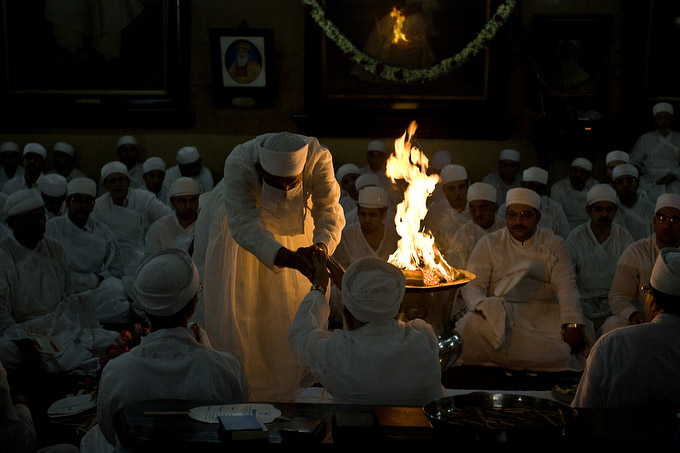
Jashan ceremony (celebration) in Mumbai in 2011, attended by 300 Zoroastrian priests. When in prayer, the priests wear vestments of snow-white, which is the colour of purity and holiness. Read more… [/] Photograph: Kainaz Amaria [/]
The Conflict of Good and Evil
David: There is also metaphysics, a cosmology, which underlies this whole process. You have spoken about the way that Zoroastrianism has influenced the Semitic religions, but would you say that Zoroastrianism itself is a monotheistic religion? Is there a concept of One God, One Reality?
Khojeste: It is monotheistic, yes, but I would prefer to use the word heno-theistic. ‘Heno’ means a belief in a supreme Godhead, with a team of divinities helping that Godhead. In my view the only religion that really promotes monotheism is Islam. Even Christianity has the concept of ‘Father, Son and Holy Ghost’, which implies a trinity, whilst Judaism has a series of prophets and is not as focused on monotheism as Islam is.
Most Zoroastrian books will certainly promote the concept of Ahura Mazda, the Wise One, as being the supreme God, the supreme Creator, and so if you want to use a Greek term, then we are a monotheistic faith. But monotheism really means the belief in one supreme Godhead, with no other divinities supporting that Godhead. However, in Zoroastrianism, we have a whole pantheon of divinities. We have the supremacy of wisdom, knowledge, and we have a team of divinities helping us to perceive that knowledge. If you see Ahura Mazda as the field marshal, then we have a hierarchy of six other divinities who are, if you like, the generals. And then we have another lot of divinities who could be seen as the officers. There is a definite scaling down from the supremacy of Ahura Mazda to his team of divinities helping Him. In that sense Zoroastrianism cannot strictly speaking be a monotheistic faith, if one understands and expects there to be just One God and nothing else in a monotheistic paradigm.
David: Islam, for instance, would see all the Divine Names as expressing different aspects of One Reality. Are these other divinity personages in Zoroastrianism not just aspects of Ahura Mazda?
Khojeste: At one level they are, certainly. But at another level they have an individuality, and therefore people have linked these divinities, which help Ahura Mazda, to the Archangels and the Angels of the Christian pantheon. I actually don’t subscribe to that point of view, because the angels in Christianity do not have individual prayers dedicated to them, whereas we do dedicate prayers to our other divinities. We believe in this concept of seven. We recognise Ahura Mazda to be supreme, the creator, all knowing, ever present, the first one – but not Almighty. This is a very important point which most people tend to question: because if we say that God is Almighty, it implies that God has the power to contain evil. This is a problem that I believe most western and eastern religions face: how do you explain the existence of evil? How do you explain why a 10-year old girl dies in a car crash, or something terrible happens to a perfectly good human being? I would like to say that Zoroastrianism perhaps is the only religion in the world that offers a logical answer as to why bad things happen to good people.
David: And what is that logical answer?
Khojeste: The logical answer is that we believe in a cosmic dualism, so we have Ahura Mazda, and we have the spirit of Ahura Mazda who is in continuous combat with the evil spirit. Does the evil spirit come from God? The answer is no; evil is the absence of God. Every other religion in the world believes that good and evil come from the same source. In Zoroastrianism, evil does not come from God. Evil is the absence of God. And therein lies the difference. You can’t say darkness comes from light, but what you can say is darkness is the absence or moving away from light. We believe that there is this constant battle going on between the forces of good and the forces of evil, until the end of time.
David: Is there parity between them?
Khojeste: No. Because eventually the forces of good will triumph over the forces of evil, and I would have to explain the whole creation story to explain how that unfolds. For the moment what I’d like to share with you is that everything negative which happens to us – in terms of misery, pain, destruction, death – are all seen as the temporary triumphs of evil. Death is a temporary triumph of evil, where evil succeeds in killing the physical body, but the soul and spirit continue their journey until the end of time, when there will be the resurrection and the last judgement.
David: What about poverty and ill health?
Khojeste: Poverty is seen as the temporary triumph of evil, as God wants us to enjoy a prosperous and happy well-being. And similarly with ill health. But as far as illness is concerned, generally we recognise that medical science is gaining ground. Day-by-day people live much longer, so our perception is that the forces of good are getting stronger and stronger versus the forces of evil. By living longer, people are enjoying much more in life than they did maybe five hundred years ago. There’s a cheerful optimism that a Zoroastrian is encouraged to believe in. We are not pessimists. We always see the glass half full rather than half empty.
David: If these two pillars of good and evil are opposed to each other and in constant conflict with each other, is that not a stressful place to be?
Khojeste: Maybe. But it’s a place that we must be in, because it’s the place our soul has chosen to come to, because we believe in one life. I understand that if I was a Syrian refugee and so many negative things were happening – I was stateless, homeless, in abject poverty – I would not be able to be as optimistic as I am sitting in front of you talking just now. However, even a Syrian refugee must dream of a better tomorrow, despite all the pain and hardship that he or she must face.
If disaster happens today in the 21st century, help goes to that disaster area much faster than it did say two hundred years ago. The fact that people live longer is a very important indicator as far as we are concerned. People live longer because things have improved in terms of food, of medical benefit, in terms of education, and so on. Zoroastrianism always upholds a positive approach to life, and this manifests itself even at a spiritual level, because a Zoroastrian is taught to be optimistic.

The sacred flame at the Ateshkadegh Fire Temple in Yazd, Iran. It is said to have been burning continuously since 470 ad
The Everlasting Fire
David: The one thing that everyone knows about Zoroastrians is that you have a particular relationship with fire, and your places of worship are fire temples. Can you say something about this?
Khojeste: Yes. When we’re talking of fire temples, we have three degrees of what we might call ‘consecrated fires’. We have the Atash Bahram fire, which one could compare to a cathedral fire. Then we have an Atash Adaran fire which is linked to, say, a church fire. And we have an Atash Dadgah fire which is linked to a chapel fire. This chapel fire is one that one can burn in your house, where one recites daily prayers.
The easiest way of explaining the significance of these fires is that a consecrated fire is always seen as the ‘Son of God’, that is, the Son of Ahura Mazda. Therefore, there’s an amazing link between the sacred fire, the concept of Truth, and Ahura Mazda. Through these fires, we are being taken into the presence of the Zoroastrian equivalent of ‘Jesus’. We were seen by the Arabs as fire worshippers, but in fact we are no more fire worshippers than the Christians are cross worshippers, or the Hindus are stone worshippers.
David: What distinguishes these three types of fire?
Khojeste: As I said, the first level is the house fire, which is a chapel fire. Then the next level up is Atash Adaran fire, which is consecrated fire taken from four different households: from the house of a priest, from the house of a soldier or warrior, from the house of a farmer, and from the house of an artisan. These four fires are taken into the fire temple complex, and it generally takes about 20 days for them to be mixed in a certain way. High rituals are performed by the priests, and eventually we get a fire which is sacred and then enthroned. This fire can only be fully experienced and ‘seen’ by Zoroastrians, because you must be in a state of religious purity or awareness to be able to, in a sense, see the ‘Son of God’.
In India we have about a hundred such fire temples where four fires have been brought together, where prayers are offered by the priest five times a day without a break, come rain or sunshine. But we only have eight cathedral fires in India, because it takes around 14,000 hours of ritual practice to consecrate a cathedral fire. These are made with sixteen different fires, taken from the house of a bricklayer, baker, priest, warrior, farmer, an artisan, as well as from the homes of other tradespeople. The fire of a burning Brahmin corpse is also taken, as well as the fire of lightning. As lightning normally strikes when it’s raining, it is a rare occurrence to find a place where lightning has struck and where the place is dry enough for the fire to ignite; furthermore, two Zoroastrians have to witness such an occurrence. But, believe it or not, despite all the odds, we do have eight cathedral fires in India.
David: Are there any fire temples left in Iran?
Khojeste: Yes. There is a very famous fire temple at Yazd [/]. But they have problems now with finding the priests to maintain these fires in the same devout way as we have managed to maintain them without a break in India.
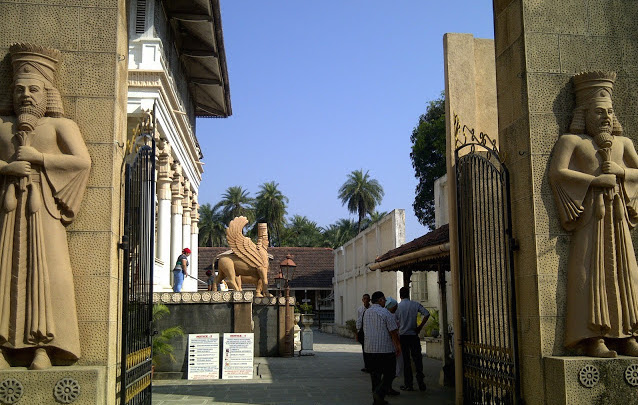
The Atesh Bahram Fire Temple at Udvada, Gujerat. The oldest Zoroastrian temple in India, its sacred flame has been maintained for more than 1000 years. Photograph: IdealIndia.com© Cooperjal Ltd 2012
David: The fires are kept burning by the priests?
Khojeste: Yes. We use hardwood, which keeps the fire burning 24/7; and we have softwood, in our case in India, sandalwood. In Iran, they don’t have sandalwood, but the texts refer to the use of any form of sweet-scented wood which can be used to feed the fire. These cathedral fires are so special that if you were to say: “Khojeste, here’s a hundred million pounds. Can you build a cathedral fire for us?” I would have to say, “No,” as we do not have the priests today with such a high level of Zoroastrian spirituality.
The oldest cathedral fire in India today burns in a small village called Udvada, some 185 kilometers north of Mumbai, where the fire has been kept continuously burning for over a thousand years. It was consecrated at a place called Sanjan, where the Parsis first arrived in India as refugees in about the 10th century, taking refuge from persecution meted out by the Arabs. To create that fire, Zoroastrian priests had to walk back to Iran to bring what is called the alat, the accoutrements, which are the sacred items that are required before one can even collect sixteen fires to make a cathedral fire. They include things like sacred ash, the hair of the white temple bull, a ring, etc.; and in order for the priests to bring these back from Iran they couldn’t use a boat, so they had to walk back from Khorasan, which is in northeastern Iran. This was a territory that Islam had conquered, and so they had to travel at night in order not be seen by zealous Arabs. They had to find the source along the Indus River, to be able to cross the Indus, by walking across the riverbed as opposed to swimming or anything like that, as they could not bring it across by boat, as fire and water cannot be in contact with each other. It was with that kind of meticulous precision and devotion and care that the alat was brought from Iran.
I am giving you this background for you to understand that, when one is talking of seeing the ‘Son of God’, it is a very special experience for us. These fires have a spirituality, and eventually they begin to communicate with the worshipper in a particular way. I could go to ten fire temples in Mumbai and not have a direct link of communication with any of them. But there may be a fire temple, say, ten miles away from my house with whom I can communicate. Our fire temples are not touristic places of interest. There is nothing architecturally spectacular about them. They have a vernacular style of architecture – very simple compared to a beautiful mosque, church, synagogue or mandir.
David: These very elaborate rituals were not specified in the original message of Zarathushtra, in the way that, say, the rules for Islam were laid down by the Prophet Muhammad. They seem to have arisen because of the sensibilities of people being educated as to their own humanity in the light of what we might call the ‘Zarathushtrian Logos’.
Khojeste: Yes. What Zarathushtra left us were hymns, a series of ecstatic, philosophical poems which are open to a lot of different interpretations. He does not talk at all about everyday use or eating food, or how you should dress, etc. However, customs and practices have developed over a period of time. What we are talking about is the preservation of a certain kind of spiritual energy, which is ethno-focused but has a universal application.
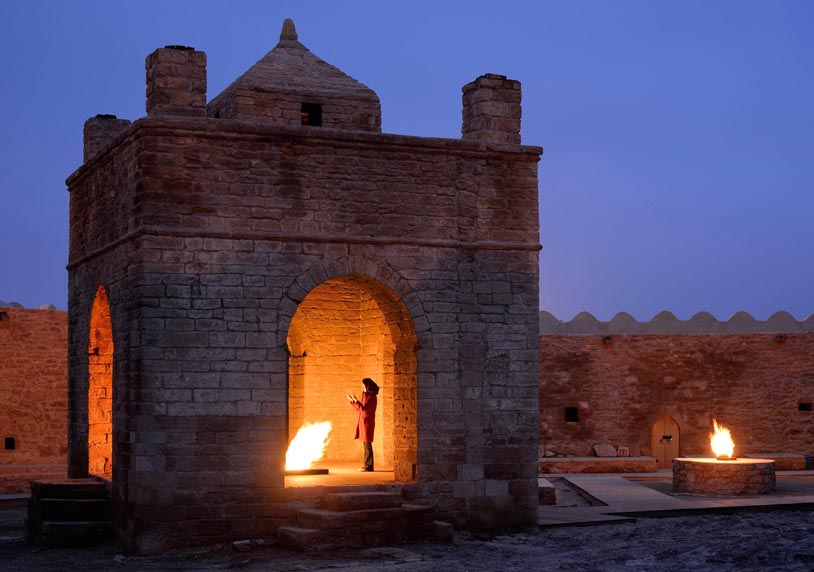
The Ateshgah temple in Baku [/], Azerbaijan, built during the 18th century by an Indian community on a natural gas field. It is no longer an active place of worship, but it is preserved as a World Heritage site and the fire is kept alight by piped gas. Photograph: Hemis / Alamy Stock Photo
Universality and Change
David: It seems a bit unfair that non-Zoroastrians can’t participate directly in and benefit from these rituals, because – at least at present – entry into Zoroastrianism is strictly on the basis of heredity.
Khojeste: Historically Zoroastrianism has been the religion of the Iranian people, and in that sense it is specific, it is particular. It doesn’t have the universality that some of the other major religions of the world do. I accept that. And yes: these rituals are exclusively done and performed by Zoroastrians for Zoroastrians. There is a movement now where some of our rituals are being done in the presence of non-Zoroastrians, particularly the outer rituals like the initiation ceremony, the marriage ceremony and the thanksgiving ceremony. But there are other ceremonies linked to the sacred fire in which only the priests and Zoroastrian laity can participate.
However, if you wanted to accept the theology of Zarathushtra in terms of what I explained earlier, you certainly could be a Zoroastrian in spirit, and also in terms of your everyday life, and follow the laws of purity, etc.
David: I understand that there is pressure now within the community to amend some of your practices. One area is your mode of burial – where bodies are laid out in the open in what are called ‘Towers of Silence’. There are problems because of a decline in the number of vultures, who are an intrinsic part of this procedure. So some people are urging the adoption of cremation instead.
Khojeste: There are almost no vultures now because of the use of diclofenac, which is administered to animals by veterinarians. This chemical has caused the death of 99% of the Gyps and White-backed vultures that used to live in our part of the world. Now there’s a lot of effort being put into bringing the vultures back, with some success. But millions of vultures died because of the use of diclofenac. It is the rays of the sun which expedite the disintegration of the corpse in the Tower of Silence. Cremation is not permitted in the Zoroastrian faith.
David: There is also some concern now about falling numbers, because many of your young people are marrying outside the religion. As a result there is a movement towards allowing conversion. But I gather you yourself don’t agree with this. There is quite a bit of controversy – bitter controversy even – concerning your position, which is seen as very traditionalist.
Khojeste: There are a number of reasons why I don’t support conversion. One is that if you look at the global situation, I don’t see that our numbers are really falling. The community in Mumbai is diminishing, it is true, but when you look at the number of Zoroastrians worldwide it is greater than ever before. Some people have emigrated and are living in the USA or Europe. Others, like the Kurds I mentioned before, are rediscovering their Zoroastrian identity and returning to the religion.
Another reason is that we are a very small religious community living amongst much larger groups, and the fact that we do not accept converts has been a very important factor in our survival over such a long period of time, because we do not represent a threat to these other religions. Also, we don’t have the facilities for conversion, or the ways and means of introducing people into the religion, as Christianity or Judaism do.

Initiation ceremony (navjote) showing the adoption of the white undervest (sudreh) and the chord (kusti) which all Zoroastrians are enjoined to wear. The vest symbolises the ‘good mind’ and is not taken off except to wash; the chord represents direction and is tied and untied with appropriate prayers five times a day. Read more… [/] Photograph: Parzor Foundation
David: So, finally, to round off all that we have covered today, what would you say makes for a good Zoroastrian life?
Khojeste: Every Zoroastrian should be a soldier of truth, be ashava, which is an Avestan word meaning ‘possessor of truth’. If we are the possessors of truth, then our job is to spread the truth. And how do we spread the truth? By being happy within ourselves and spreading harmony in the environment, which nowadays we call ‘ecology’. Live a happy and contented life by upholding the truth would be my Zoroastrian message to others.
Cartoon by Simon Blackwood
Image Sources (click to open)
Banner: Faravahar, the Zoroastrian symbol, at the entrance of the Ateshkadegh Fire Temple in Yazd, Iran. The sacred flame is said to have been burning continuously since 470 ce. Photograph: EmmePi Travel / Alamy Stock Photo.
First inset image: Khojeste Mistree. Photograph: vqr on-line (https://www.vqronline.org/reporting-articles/2015/09/indias-vanishing-vultures)
Translation of the Gāthā Ahunavaita by Dastur Framroze Ardeshir Bode and Piloo Nunavatty, in Songs of Zarathustra (George Allen & Unwin, 1951)
Other Sources (click to open)
For a short video introduction to Zoroastrianism, see https://www.youtube.com/watch?v=eLM7jFAYyOc
The website of the SOAS exhibition The Everlasting Flame gives an excellent introduction to some aspects of Zoroastrianism; see http://www.theeverlastingflame.com/narrative/index.html
For more on sky ‘burials’, see https://www.vqronline.org/reporting-articles/2015/09/indias-vanishing-vultures.
Books
Khojeste P. Mistree, Zoroastrianism: an ethnic perspective (Square, Mumbai, 1982,1998)
Robert C. Zaehner
Teachings of the Magi (George Allen & Unwin, 1956)
Mysticism Sacred and Profane (Oxford University Press, 1969)
The Baghavad Gita (Oxford University Press USA, 1973)
Mary Boyce, The History of Zoroastrianism, Vols. 1, 2 & 3 (Handbuch der Orientalistik Series, Brill, 1975, 1982, 1991)
Rohinton Mistry
Tales from Firozsha Baag (Penguin Canada,1987)
Such a Long Journey (McClelland and Stewart, Toronto, 2008)
Email this page to a friend
FOLLOW AND LIKE US
——————————————
——————————————
——————————————
FOLLOW AND LIKE US
If you enjoyed reading this article
Please leave a comment below.
Please also consider making a donation to support the work of Beshara Magazine. The magazine relies entirely on voluntary support. Donations received through this website go towards editorial expenses, eg. image rights, travel expenses, and website maintenance and development costs.
READ MORE IN BESHARA MAGAZINE
The Unity of Humanity
Professor Todd Lawson on the universal vision of the Qur’ān
A Caravan on a Spiritual Silk Road
Warren Kenton on the profound wisdom of the Kabbalah
Yoga: A Spiritual Practice for Our Time
An interview with Judith Hanson Lasater
Choje Akong Tulku Rinpoche
Vin Harris talks about the life of a remarkable man
READERS’ COMMENTS

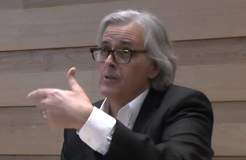
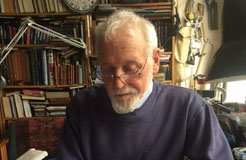

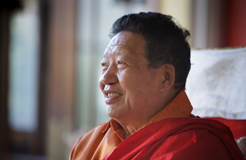
Very beautifully explained. Blessings of Ahura Mazda on all humanity.
HI, could you please explain more on “David: At the time of the Achaemenian Empire – which was huge, stretching from Eastern Europe to Sind in India – Zoroastrianism was the state religion, and it continued to be so under the Parthians and Sassanians. So for many centuries it was the dominant faith in the Middle East. But these days, I believe the number of followers is relatively small, about 125,000 people.”. Many thanks. I have bookmarked your website for future use.